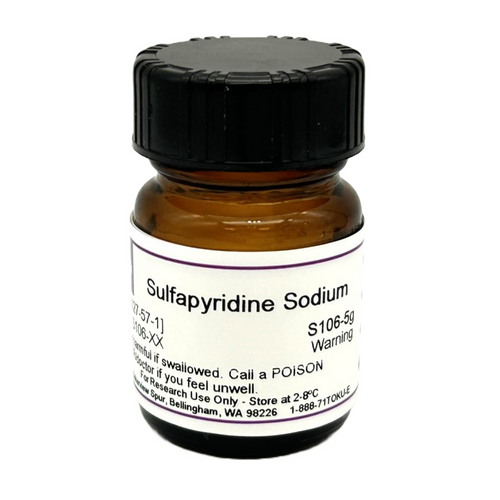Sulfapyridine, USP is a first generation sulfonamide discovered in 1937 by L Whitby (May & Baker) and originally named M&B693. Sulfapyridine has anti-inflammatory properties and can be used in studies of immunodeficiency and inflammation. It can also be used in oxygen radical absorbance capacity (ORAC) where it scavenges peroxyl radicals. A related compound is sulfasalazine which is one molecule of sulfapyridine linked to one molecule of mesalamine with an azo chemical linker.
Sulfapyridine is practically insoluble in water. Formulations with sodium have similar potency and improved water solubility.
We also offer:
- Sulfapyridine Sodium (S106)
| Mechanism of Action | Sulfapyridine inhibits folic acid synthesis by acting as a competitive inhibitor of dihydropteroate synthetase, an enzyme found in the folic acid synthesis pathway. The reaction is needed for the synthesis of folic acid by means of processing the substrate para-aminobenzoic acid (PABA). THis enzyme is required for folate synthesis, which is needed for cells to manufacture nucleic acids. |
| Spectrum | Sulfapyridine has broad-spectrum activity against most Gram-positive and many Gram-negative organisms. |
| Microbiology Applications |
Sulfapyridine can be used to study inflammation. Many bacterial strains may be resistant, and resistance to one sulfonamide indicates resistance to all. |
| Eukaryotic Cell Culture Applications |
Sulfapyridine (SP) and 5-aminosalicylic acid (5-ASA) are two primary metabolites of the anti-inflammatory salicylazosulfapyridine (SASP). They were studied in mammalian cells, both in vitro and in vivo, to understand the genetic effects produced by SASP. They were tested for induction of sister-chromatid exchanges (SCE) and chromosomal aberrations (Abs) in Chinese hamster ovary (CHO) cells in vitro. SP gave positive results in the in vitro SCE test. They were also tested in vivo for induction of micronuclei (MN) in mouse bone marrow polychromatic erythrocytes (PCE). Sulfapyridine also gave positive results in the in vivo MN test. Therefore, it is Sulfapyridine that induces chromosomal damage when SAPS is used. Chronic inflammatory diseases are associated with NF-kB activation and impaired apoptosis of immune cells. Researchers investigated if Sulfapyridine affected NF-kB/Rel activation and T-lymphocyte viability. It was found that it neither inhibited nor induced apoptosis in T-lymphocytes at doses up to 5 mM (Liptay et al, 1999). |
| Molecular Formula | C11H11N3O2S |
| References |
Ghorab MM, Ragab FA, Heiba HI and Bayomi AA (2014) Novel quinazoline derivatives bearing a Sulfapyridine moiety as anticancer and radiosensitizing agents. J. Heterocyclic Chem. 51(S1):E255-E262 Henry RJ (2012) The mode of action of sulfonamides. Bacteriol. Rev. (n.d.): 175-84 Liptay S et al (1999) Inhibition of nuclear factor kappa B and induction of apoptosis in T-lymphocytes by sulfasalazine. British J. Phamacol. 128(7):1361-1369 Paniker U and Levine (2001) Dapsone and Sulfapyridine. Dermatol. Clinics 19(1):79-86 Reid RD (1939) Observations on the mode of action of Sulfapyridine on Pneumococcus. Proc. Soc. Exp. Biol. Med. 41(2):437-442 Witt KL, Bishop JB, McFee AF, Kumaroo V (1992) Induction of chromosomal damage in mammalian cells in vitro and in vivo by Sulfapyridine or 5-aminosalicylic acid. Mut. Res. Lett. 283(1):59-64 PMID 1380664 |








